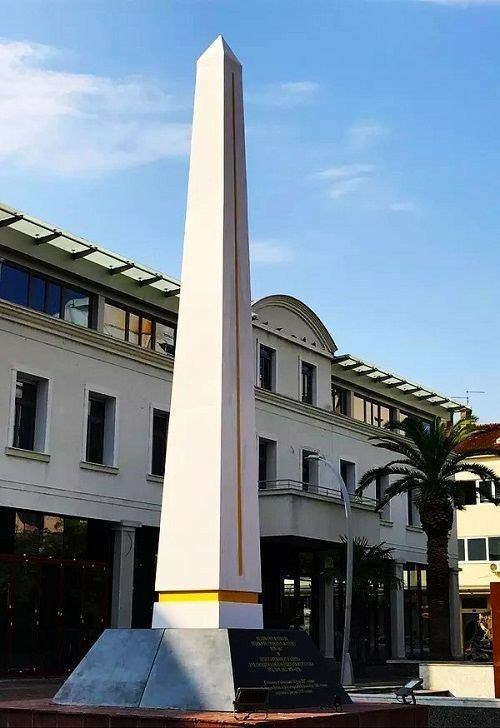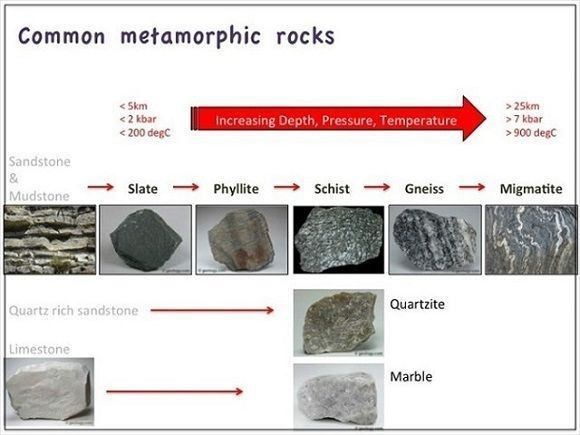The monument to Grand Duke Mirko Petrović was placed on Independence Square in the center of Podgorica.
On the pedestal is written "To the Grand Duke Mirko Petrović, 1820-1867 and Montenegrin heroes who participated in the liberation wars of 1853, 1862, 1876-1878".
As explained, the pedestal of the monument, which is made of two parts, is made of granite from India, it weighs 26 tons. The granite was shipped from India to Italy, and then to Sarajevo, where it was processed and shipped to Podgorica, while the main part of monument is from marble from Prilep.
Based on the old monument to Mirko Petrović, is an obelisk made of marble, 10 meters high, the work of the famous artist Dimitrije Popović.

Metamorphic rocks have been modified by heat, pressure, and chemical processes, usually while buried deep below Earth's surface. Exposure to these extreme conditions has altered the mineralogy, texture, and chemical composition of the rocks.
There are two basic types of metamorphic rocks. Foliated metamorphic rocks such as gneiss, phyllite, schist, and slate have a layered or banded appearance that is produced by exposure to heat and directed pressure.
Non-foliated metamorphic rocks such as hornfels, marble, quartzite, and novaculite do not have a layered or banded appearance.
Marble as mentioned above is a non-foliated metamorphic rock, it is produced from the metamorphism of limestone or dolomitestone. It is composed primarily of calcium carbonate.
Metamorphism changes original, preexisting rock into a new type of rock and this change happens in one of three ways:
1. Contact with heat – This type of metamorphism is called contact metamorphism or thermal metamorphism. It occurs when magma moves through existing rocks and brings high levels of heat. The surrounding rock is heated enough to cause changes in the mineral structures.
2. Burial under rocks and sediment – This type of metamorphism is called burial metamorphism. It affects rocks that are buried at great depth (more than 10 kilometers). These rocks are exposed to heat and pressure and their minerals are changed because of that.
3. Direct pressure and heat from plate collisions – This type of metamorphism is called dynamothermal metamorphism. It happens when two crustal plates collide and the pressure and heat from this process cause changes in preexisting rocks.

Burial metamorphism and dynamothermal metamorphism affect large areas and they are both considered regional metamorphism. Contact metamorphism affects only rocks immediately surrounding the heated materials and it is considered local metamorphism.
There are two basic textures of metamorphic rocks: foliated and non-foliated. Foliated metamorphic rocks are formed when direct pressure from two opposite directions elongates the minerals into parallel layers. Non-foliated metamorphic rocks are formed by contact with heated magma and by indirect pressure. Minerals in non-foliated rocks are also changed but they do not create layers.

Marble is a metamorphic rock that forms when limestone is subjected to the heat and pressure of metamorphism. When it is formed from a limestone with very few impurities, it will be white in color. It is composed primarily of the mineral calcite (CaCO3) and usually contains other minerals, such as clay minerals, micas, quartz, pyrite, iron oxides, and graphite. Under the conditions of metamorphism, the calcite in the limestone recrystallizes to form a rock that is a mass of interlocking calcite crystals. A related rock, dolomitic marble, is produced when dolostone is subjected to heat and pressure.
Mineralogy: 95% calcite (CaCO3) or dolomite Ca,Mg(CO3)2. Impurities may give rise to new minerals such as olivine.
Marble’s geological classification is defined as a metamorphic rock predominantly consisting of fine- to coarse-grained, recrystallized calcite. Basically, the texture of the marble has a range from small/uniform crystals to large less consistent crystals. Marble stone is formed by two main processes; recrystallization and metamorphism. Another, more general definition of marble is any crystallized carbonate rock or certain types of limestone that take a polish finish and can be used as architectural or ornamental stone. It should be noted that marble made by the process of metamorphism makes the marble tighter, denser, and fracture-free. Marble is classified into four different groups known as the Marble Soundness Classification.
Marble classification groups:
Group A:Sound marbles with uniform crystals are favorable for working qualities containing no geological flaws or voids. They do not require any filling or packing.
Group B: Marbles similar in character to Group A, except that all the impurities have not changed into other minerals. They have occasional small holes and voids. However, the holes or voids are filled by the Marble Craftsman with epoxy, shellac, or polyester resin.
Group C: Marbles with some variations in working qualities. This group is prone to have geological flaws, voids, veins, and lines of separation. This is the largest and most colorful group of marbles, and also contains significant holes, voids, lines of separation, and structural flaws.
Group D: These marbles are similar to the previous groups, but also contain a larger proportion of natural faults. They have maximum variations in working qualities. These marbles can fracture more easily due to the additional veins and larger crystals.

Color: Marble is usually a light-colored rock. When it is formed from a limestone with very few impurities, it will be white in color. Marble that contains impurities such as clay minerals, iron oxides, or bituminous material can be bluish, gray, pink, yellow, or black in color. Marble of extremely high purity with a bright white color is very useful. It is often mined, crushed to a powder, and then processed to remove as many impurities as possible. The resulting product is called "whiting." This powder is used as a coloring agent and filler in paint, whitewash, putty, plastic, grout, cosmetics, paper, and other manufactured products.
Mineral Colours: Iron Oxide - Red or Orange, Iron and Feldspar - Pink or Red, Serpentine – Green, Porphyry – Violet, Chlorite – Green, Graphite - Black/Grey, Limonite – Yellow, Muscovite - Specks of silver, Biotite - Specks of black, Lepidolite - Specks of violet.

Acid Reaction: Being composed of calcium carbonate, marble will react in contact with many acids, neutralizing the acid. It is one of the most effective acid neutralization materials. Marble is often crushed and used for acid neutralization in streams, lakes, and soils. It is used for acid neutralization in the chemical industry as well. Pharmaceutical antacid medicines such as "Tums" contain calcium carbonate, which is sometimes made from powdered marble. These medicines are helpful to people who suffer from acid reflux or acid indigestion. Powdered marble is used as an inert filler in other pills.
Hardness: Being composed of calcite, marble has a hardness of three on the Mohs hardness scale. As a result, marble is easy to carve, and that makes it useful for producing sculptures and ornamental objects. The translucence of marble makes it especially attractive for many types of sculptures. The low hardness and solubility of marble allows it to be used as a calcium additive in animal feeds. Calcium additives are especially important for dairy cows and egg-producing chickens. It is also used as a low-hardness abrasive for scrubbing bathroom and kitchen fixtures.

Prilep Quarry
In Prilep are high-quality marbles used for sculptural purposes and for decorative architecture in antiquity. Are usually calcitic marbles, and artefacts made of calcite marble by far outnumber the works of art made of dolomitic marble. Major sources of high-quality dolomitic marbles in antiquity are rare, and the only prominent ones are the fine-grained dolomites.

How to log this cache:
To log this cache, take a picture of monument made from the marble rock at the coordinates. You also need to answer the following questions and answers send me to email in the profile:
1. Is it possible to observe skeletons or fossils in the marble of monument (explain your answer)?
2. Observe the marble in the monument, and tell me if texture is foliated or non-foliated?
3. Observe the marble in the monument, can you tell me by the color of the marble, if the marble is pure or contains impurities (explain your answer)?
4. In addition to the obvious calcite minerals (white) what other minerals are present in this marble and what percentage of the rock do they make up in total?
5. Observe the marble in the monument, and tell me if the monument is a monolith or is it composed of several blocks of marble?
6. Please post a photo of yourself, or GPS with the marble rock from the monument.
Feel free to log this cache. You do not need to wait for permission to log. If your answers are not correct, incomplete, I will contact you by e-mail. But if your e-mail is not coming to me within 3 days from your log, I will delete your log without notice.

Како пријавити ову кеш меморију:
Да бисте забележили овај кеш, сликајте споменик направљен од мермерне стене на координатама. Такође треба да одговорите на следећа питања и одговоре ми пошаљите на мејл у профилу:
1. Да ли је могуће посматрати скелете или фосиле у мермеру споменика (објасните свој одговор)?
2. Посматрајте мермер на споменику и реците ми да ли је текстура фолирана или не?
3. Посматрајте мермер у споменику, можете ли ми по боји мермера рећи да ли је мермер чист или садржи нечистоће (објасните свој одговор)?
4. Поред очигледних минерала калцита (белог) који други минерали су присутни у овом мермеру и колики проценат стене они укупно чине?
5. Посматрајте споменик, реците ми да ли је споменик монолит или се састоји од неколико блокова мермера?
6. Молимо вас да поставите своју фотографију или ГПС са мермерном стеном са споменика.
Слободно пријавите ову кеш меморију. Не морате да чекате дозволу да се пријавите. Уколико Ваши одговори нису тачни, непотпуни, контактираћу Вас мејлом. Али ако ми ваша е-пошта не стигне у року од 3 дана од вашег дневника, избрисаћу ваш дневник без обавештења.
Used sources: